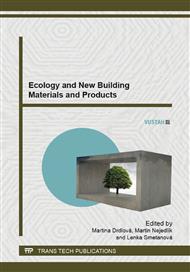p.294
p.298
p.302
p.306
p.310
p.314
p.318
p.322
p.326
Properties of Lightweight Thermal Insulation Plasters
Abstract:
The design of thermal insulation plasters is closely connected with their apparent density and the binder used where low apparent density may fetch very good thermal insulation properties. What matters is the correct composition of the plaster mix system being designed. The choice of binder, other components and especially aggregate taking up a dominant part in the system is also important. A suitable aggregate is expanded obsidian which has very low density with open pore structure which has positive influence on thermal insulation properties.
Info:
Periodical:
Pages:
310-313
Citation:
Online since:
August 2014
Authors:
Price:
Сopyright:
© 2014 Trans Tech Publications Ltd. All Rights Reserved
Share:
Citation:


